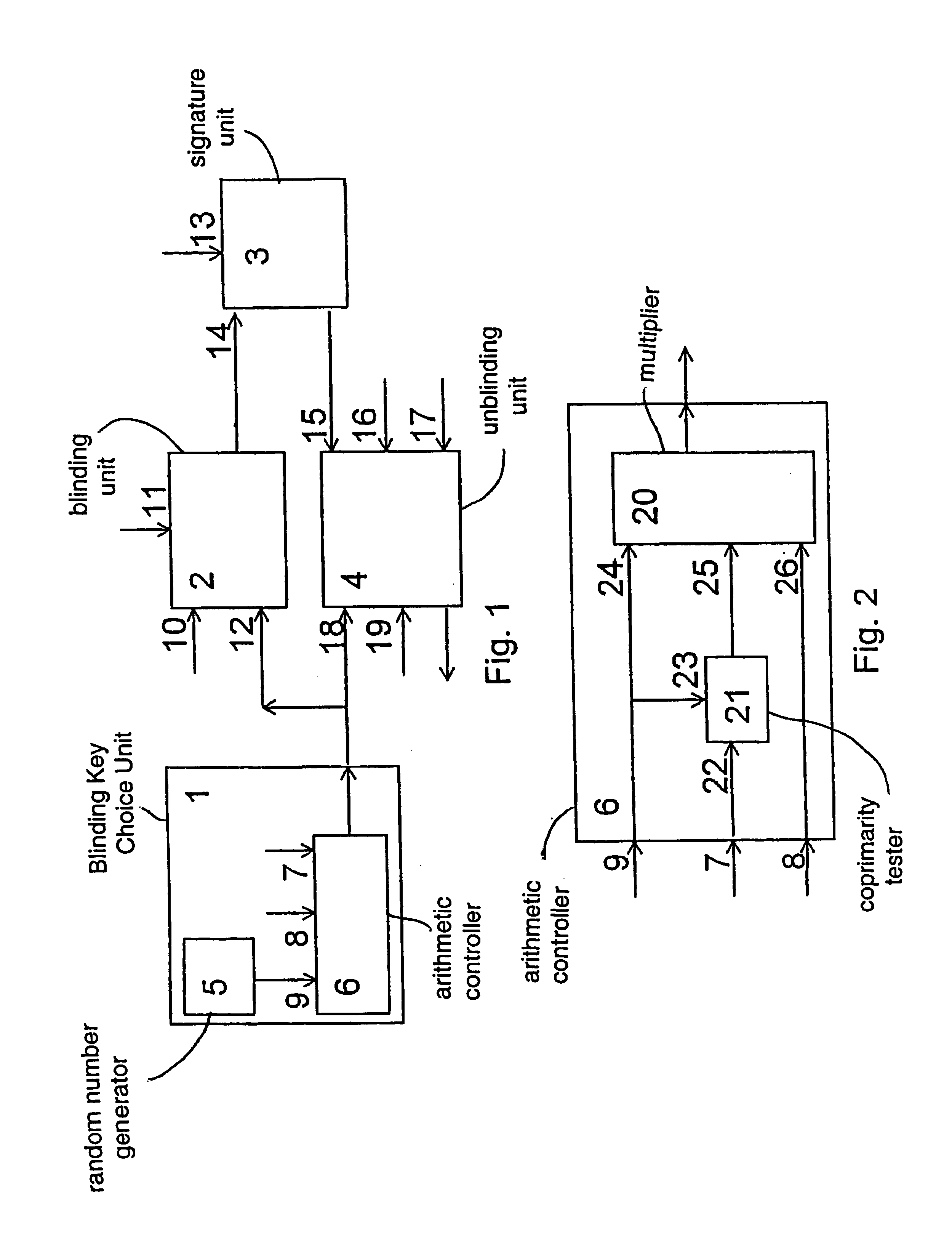Method for making a blind RSA-signature and apparatus therefor
a digital signature and blind technology, applied in the field of cryptographic systems, can solve the problems of not being able to obtain practical impossibility, and rsa-key does not ensure the privacy of suppliers, and achieves the effects of small resources, rapid making a blind digital signature, and high unanticipatability
- Summary
- Abstract
- Description
- Claims
- Application Information
AI Technical Summary
Benefits of technology
Problems solved by technology
Method used
Image
Examples
example 2
[0068]The signer chooses integers E1=3, E2=5, E3=7 as the basic public RSA-exponents. The signer takes two prime numbers P and Q having size of 512 bits and the RSA-module N=P·Q, which is obtained from P and Q with the help of a multiplier, as the secret factors. Furthermore, the secret factors are chosen to be such that each of the integers P−1, Q−1, and N−1 is coprime to each basic public RSA-exponent. Such secret factors are chosen by testing the mentioned properties of trial secret factors, which are prime numbers having size of 512 bits and obtained with the help of the cryptographic random-number generator. The choice of such prime numbers and their testing are performed in one of the known ways (A. J. Menezes, P. C. Van Oorshot, S. A. Vanstone, Handbook of Applied Cryptography, CRC Press, 1997, p. 145). The chosen RSA-module N and the chosen basic admissible exponents are made public.
[0069]As the initial data M, the supplier takes an arbitrary integer representing the data to...
example 3
[0074]Though in real digital RSA-signature systems the secret factors are used consisting of many dozens of digits, for the sake of simplicity in this example the secret factors consist of a small number of digits. Suppose that the signer has chosen the secret factors P=419 and Q=863, the RSA-module N=361597, and the public RSA-exponent E=3, and after that the signer has communicated N and E to all interested parties. Suppose that the supplier wishes to obtain a blind digital RSA-signature of the initial data M=123456. For this purpose, the supplier feeds the initial data M to the initial data input 10, and the RSA-module N to the module input 11 of the blinding unit 2. In addition, the supplier feeds the public RSA-exponent E to the first limiting input 7 of the arithmetic controller 6, and the RSA-module N decremented by 1, i.e., the integer 123455, to the second limiting input 8 of the arithmetic controller 6. Suppose that the integer R=901 appears at the output of the blinding k...
example 4
[0076]The example is illustrated by FIG. 1 and FIG. 2. FIG. 2 shows arithmetic controller 6, which has an inadmissible divisor input 7, an obligatory divisor input 8, a trial data input 9, comprises a multiplier 20 and a coprimality tester 21. Here, the inadmissible divisor input 7 is connected to an input 22 of the coprimality tester, the trial data input 9 is connected to an input 23 of the coprimality tester and to an argument input 24 of the multiplier 20, an output of the coprimality tester 21 is connected to a load input 25 of the multiplier 20, the obligatory divisor input 8 of the arithmetic controller 6 is connected to an argument input 26 of the multiplier 20 which output is connected to the output of the arithmetic controller 6.
[0077]A specific example of functioning of the blinding key choice unit 1 of the above-described apparatus for making a blind digital RSA-signature is as follows. Suppose that the integer 1234 appears at the output of the random-number generator 5 ...
PUM
 Login to View More
Login to View More Abstract
Description
Claims
Application Information
 Login to View More
Login to View More - R&D
- Intellectual Property
- Life Sciences
- Materials
- Tech Scout
- Unparalleled Data Quality
- Higher Quality Content
- 60% Fewer Hallucinations
Browse by: Latest US Patents, China's latest patents, Technical Efficacy Thesaurus, Application Domain, Technology Topic, Popular Technical Reports.
© 2025 PatSnap. All rights reserved.Legal|Privacy policy|Modern Slavery Act Transparency Statement|Sitemap|About US| Contact US: help@patsnap.com



